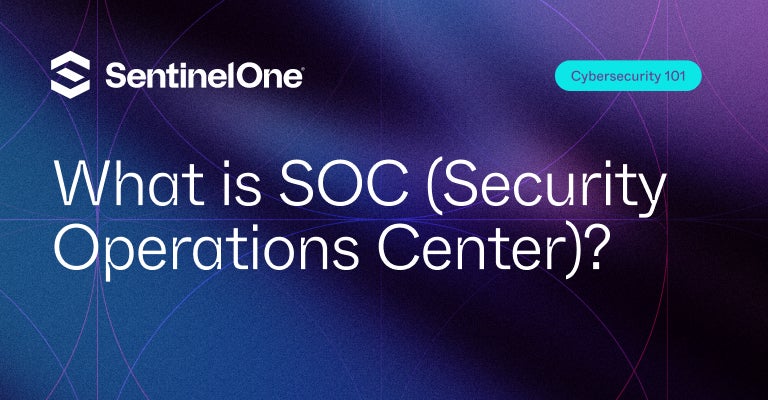A Security Operations Center (SOC) is a centralized unit that monitors and analyzes an organization’s security posture. This guide explores the functions of a SOC, its importance in incident detection and response, and the technologies used.
Learn about the roles within a SOC and best practices for establishing an effective security operations strategy. Understanding SOC is crucial for organizations to enhance their cybersecurity capabilities.

What is a Security Operations Center (SOC)?
A Security Operations Center, or SOC, is a centralized facility where a team of cybersecurity experts works together to monitor, detect, analyze, and respond to various security incidents within an organization’s digital infrastructure. The primary objective of a SOC is to minimize the impact of cyberattacks, protect sensitive data, and ensure the confidentiality, integrity, and availability of your organization’s information assets.
Why Your Business Needs a SOC
With cyberattacks becoming increasingly sophisticated and frequent, a SOC is essential for businesses of all sizes. Here’s why:
- Proactive Threat Detection: SOCs continuously monitor your organization’s network, systems, and applications to identify potential vulnerabilities and detect any signs of malicious activity.
- Rapid Incident Response: When a security incident is detected, the SOC team quickly takes action to contain the threat and minimize damage, ultimately reducing the overall impact on your business.
- Compliance Assurance: By implementing security best practices and industry-standard frameworks, SOCs help your organization adhere to regulatory requirements and maintain compliance with data protection laws.
- Improved Security Posture: The combination of advanced technology, skilled personnel, and well-defined processes in a SOC helps your business maintain a strong security posture in the face of evolving threats.
Key Components of a Security Operations Center
A successful SOC relies on several critical components, including:
- People: A SOC team is composed of cybersecurity professionals with various skill sets, such as security analysts, incident responders, threat hunters, and forensic experts. These individuals collaborate to monitor, detect, and respond to security threats in real time.
- Processes: Clearly defined processes and workflows are essential for the efficient functioning of a SOC. These processes include incident management, threat detection, vulnerability management, and threat intelligence.
- Technology: A SOC employs a variety of advanced security tools and technologies to monitor and analyze vast amounts of data. These tools include Security Information and Event Management (SIEM) systems, intrusion detection systems (IDS), firewalls, endpoint protection platforms, and threat intelligence feeds.
- Threat Intelligence: SOC teams use threat intelligence to stay up-to-date on the latest threat actors, attack techniques, and vulnerabilities. This information allows them to proactively identify and respond to potential threats before they can cause significant harm.
Types of Security Operations Centers
There are various types of SOCs, each with its advantages and drawbacks:
- In-house SOC: An organization builds and operates its own SOC, employing a dedicated team of cybersecurity professionals. This approach offers complete control over security operations but can be resource-intensive.
- Outsourced SOC: A third-party provider monitors and manages an organization’s security. This can be a cost-effective solution for businesses with limited resources or expertise but may result in less control and visibility into security operations.
- Hybrid SOC: This model combines the benefits of both in-house and outsourced SOCs. Organizations maintain an internal SOC team while leveraging an external provider’s expertise and resources. This approach offers a balance between control, cost, and access to specialized skills.
Building a Successful Security Operations Center
To build a successful SOC, consider the following best practices:
- Define clear objectives: Establish the goals and objectives of your SOC based on your organization’s unique needs, risk tolerance, and regulatory requirements. This will help you design and implement an effective security strategy.
- Assemble a skilled team: Hire experienced cybersecurity professionals with diverse skill sets, including security analysts, incident responders, and threat hunters. Invest in ongoing training and development to keep your team’s skills up-to-date.
- Implement robust processes: Develop and document well-defined processes for incident management, threat detection, vulnerability management, and threat intelligence. Continually review and refine these processes to ensure optimal performance.
- Leverage advanced technology: Deploy a range of security tools and technologies, such as SIEM systems, XDR, firewalls, and endpoint protection platforms. Regularly update and fine-tune these tools to ensure they remain effective against evolving threats.
- Foster a strong security culture: Promote a security-first mindset throughout your organization by providing regular security awareness training, encouraging collaboration between teams, and rewarding proactive security behaviors.
- Measure SOC performance: Establish Key Performance Indicators (KPIs) to measure the effectiveness of your SOC. Monitor these KPIs closely and use them to identify areas for improvement.
- Continuously improve: Regularly review and assess your SOC’s performance, and make necessary adjustments to address any gaps or weaknesses. Stay abreast of industry trends and best practices to ensure your SOC remains at the forefront of cybersecurity.
The Future of Security Operations Centers
SOCs must adapt and innovate as cyber threats evolve to stay ahead of the curve. Emerging trends and technologies that will shape the future of SOCs include:
- Artificial Intelligence (AI) and Machine Learning (ML): AI and ML can augment human analysts by automating routine tasks, analyzing vast amounts of data, and identifying patterns that may indicate a cyber threat. This allows SOC teams to focus on higher-level strategic activities and respond more effectively to incidents.
- Extended Detection and Response (XDR): XDR platforms consolidate and correlate data from multiple security tools, providing a holistic view of an organization’s security posture. SOC teams can detect and respond to threats more quickly and efficiently.
- Cloud-based SOCs: As more organizations move to the cloud, the need for cloud-based SOCs will grow. These SOCs must be designed to secure cloud-native applications, infrastructure, and data while maintaining the cloud’s flexibility and scalability.
- Cyber Threat Intelligence Sharing: Collaborating with industry peers and sharing threat intelligence helps SOCs stay informed of emerging threats and respond more effectively to attacks.
Singularity™ MDR
Get reliable end-to-end coverage and greater peace of mind with Singularity MDR from SentinelOne.
Get in TouchConclusion
A Security Operations Center (SOC) is critical to any organization’s cybersecurity strategy. By combining skilled personnel, robust processes, advanced technology, and a proactive approach to threat detection and response, SOCs help enterprises maintain a strong security posture in the face of ever-evolving cyber threats.
Organizations can better protect their digital assets and ensure business continuity by understanding the key components, types, and best practices for building a successful SOC. As the cybersecurity landscape continues to change, SOCs must adapt and evolve to remain at the forefront of enterprise security.
Security Operations Center FAQs
A Security Operations Center is a centralized team that watches over an organization’s networks, systems, and 24/7. Analysts use tools to detect threats, investigate alerts, and coordinate responses.
The SOC gathers logs and events, triages incidents, and works with IT to fix issues. It acts as the nerve center for cybersecurity, making sure attacks get spotted and handled before they cause damage.
Threats move fast and strike any business, big or small. A SOC gives you constant monitoring so you catch suspicious activity right away. Without a SOC, alerts pile up and you risk missing real attacks. Having dedicated analysts, clear processes, and the right tools means you can stop breaches before they spread, protect your data, and keep customers and regulators happy.
A SOC collects logs, alerts, and threat intelligence from firewalls, endpoints, and cloud services. It triages and investigates incidents, prioritizing what needs an urgent fix. The team performs threat hunts to spot hidden attackers, runs malware analysis, and handles incident response playbooks.
They also report metrics, refine detection rules, and share lessons learned to strengthen defenses over time.
SOCs pull in data from SIEM platforms that aggregate logs and alerts. EDR agents on endpoints catch malware and ransomware. Firewalls and network sensors track incoming traffic. Threat intelligence feeds add context about known attackers.
Automation and orchestration tools help analysts sift through alerts and run routine tasks, freeing up time to focus on real threats and deeper investigations.
By logging events, tracking who did what, and keeping detailed incident reports, a SOC creates an audit trail that meets rules like PCI, HIPAA, or GDPR. Regular vulnerability scans, patch tracking, and policy enforcement show auditors you follow standards.
When regulators ask for evidence, you can quickly produce logs and reports to prove you handled risks and responded to incidents properly.
Start with clear alert triage: filter out noise and focus on real threats. Next, follow incident response steps—contain, eradicate, recover, and document. Schedule regular threat hunting to unearth hidden risks. Maintain playbooks aligned to common attacks.
Review and tune detection rules often. Finally, hold post-incident reviews to learn what worked and where you can improve your tools and processes.
AI models sift through mountains of logs to spot odd patterns that humans might miss. Automated playbooks can quarantine endpoints, block IPs, and send alerts without waiting for a person.
This cuts response time from hours to minutes and frees analysts to focus on complex investigations. As a result, you catch more attacks early and get more value out of your SOC team.
XDR integrates EDR, network telemetry, email, and cloud logs into a single console. Instead of juggling separate tools, analysts see linked events across endpoints, network, and apps. This unified view makes it easier to spot multi-stage attacks and speeds up root cause analysis. XDR also automates cross-domain playbooks, so you can contain threats across the entire environment in one click.
Finding skilled analysts can be tough since demand outstrips supply. It takes time to tune detection rules and onboard new data sources. Alert overload leads to burnout if you lack automation.
Budget constraints may limit tool coverage or staffing. Keeping up with emerging threats and new compliance mandates means ongoing training and process updates—otherwise your SOC falls behind.
SOCs will shift more analytics and routine tasks to AI and cloud services, so you need fewer on-prem servers. Autonomous playbooks will detect and block attacks without human steps, then alert analysts for review. AWS, Azure, and GCP will offer native SOC-like services you can plug into. Teams will focus on strategic hunts, threat intelligence, and guiding automated systems rather than manual monitoring.
SentinelOne Singularity unifies endpoint, cloud, and identity data into one console, giving SOC teams full visibility. Its behavioral AI spots threats in real time and auto-remediates malware or misconfigurations. Built-in playbooks and APIs let you automate containment, forensics, and recovery steps. With guided investigations and threat hunting queries, analysts spend less time stitching data together and more time stopping attacks.


